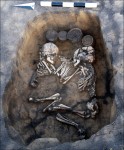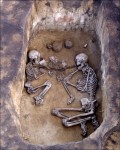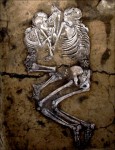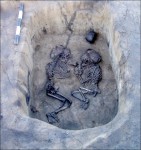 Dozens of burials in the southwestern Siberian village of Staryi Tartas have been found with human remains posed in pairs facing each other. The rare couple burials are among 600 graves dating to between the 17th and 14th centuries B.C. from the Bronze Age Andronovo culture. Although some subsets of the nomadic Eurasian cultural family cremated their dead, others are well known for inhuming them in crouched positions. The discovery that gave them their modern name, in fact, was a number of burials found in the village of Andronovo, southern Siberia, in 1914.
Dozens of burials in the southwestern Siberian village of Staryi Tartas have been found with human remains posed in pairs facing each other. The rare couple burials are among 600 graves dating to between the 17th and 14th centuries B.C. from the Bronze Age Andronovo culture. Although some subsets of the nomadic Eurasian cultural family cremated their dead, others are well known for inhuming them in crouched positions. The discovery that gave them their modern name, in fact, was a number of burials found in the village of Andronovo, southern Siberia, in 1914.
 Unlike the Lovers of Valdaro and the so-called Romanian “Romeo and Juliet”, these burials are not necessarily romantic pairings. Some are of children, some are one adult and a child or children. Some are face to face, some are spooning, some are on their backs holding hands.
Unlike the Lovers of Valdaro and the so-called Romanian “Romeo and Juliet”, these burials are not necessarily romantic pairings. Some are of children, some are one adult and a child or children. Some are face to face, some are spooning, some are on their backs holding hands.
 The grave goods help identify the burials as from the Andronovo Culture, but don’t provide any specific information about the deceased. Grave goods include pottery decorated in geometric patterns including swastikas, metal artifacts and weapons, bone arrowheads, even a very rare stone casting mould used to make metal jewelry. (The Andronovo were expert metallurgists who mined copper and tin and made bronze artifacts from them. As the migrated, they are thought to have brought metal working techniques with them.)
The grave goods help identify the burials as from the Andronovo Culture, but don’t provide any specific information about the deceased. Grave goods include pottery decorated in geometric patterns including swastikas, metal artifacts and weapons, bone arrowheads, even a very rare stone casting mould used to make metal jewelry. (The Andronovo were expert metallurgists who mined copper and tin and made bronze artifacts from them. As the migrated, they are thought to have brought metal working techniques with them.)
 With little hard data to go on, speculation about the significance of the funerary arrangements is rife. The women paired with men could have been sacrificed after the death of the man, for example, as in some Scythian burials. It could have been a form of posthumous or ghost marriage, a practice seen in many cultures from Asia (China, India) to Africa (Sudan) and Europe (France during World War I). Alternatively, bodies could have been added over time and carefully positioned with the previous resident(s) of the grave instead of interred simultaneously. The symbolism could be more familial than romantic, an homage to the burgeoning importance of the nuclear family unit.
With little hard data to go on, speculation about the significance of the funerary arrangements is rife. The women paired with men could have been sacrificed after the death of the man, for example, as in some Scythian burials. It could have been a form of posthumous or ghost marriage, a practice seen in many cultures from Asia (China, India) to Africa (Sudan) and Europe (France during World War I). Alternatively, bodies could have been added over time and carefully positioned with the previous resident(s) of the grave instead of interred simultaneously. The symbolism could be more familial than romantic, an homage to the burgeoning importance of the nuclear family unit.
Researchers are hoping DNA analysis may illuminate the relationships between the buried and thus answer some of these questions.
“[W]e need to firstly establish unequivocally the kinship of those who were buried,” said Professor Molodin [of the Institute of Archeology and Ethnography of the Siberian Branch of the Russian Academy of Sciences] referring to the necropolis close to the confluence of the rivers Tartas and Om. “Until recently archaeologists had no such opportunity, they could establish only the gender and age. But now as we have at our disposal the tools of paleogenetics, we could speak about establishing the kinship.” […]
“For example, we found the burial a man and a child. What is a degree of their kinship? Are they father and son or….? The same question arises when we found a woman and a child. It should seem obvious – she is the mother. But it may not be so. She could be an aunt, or not a relative at all. To speak about this scientifically we need the tools of paleogenetics.”